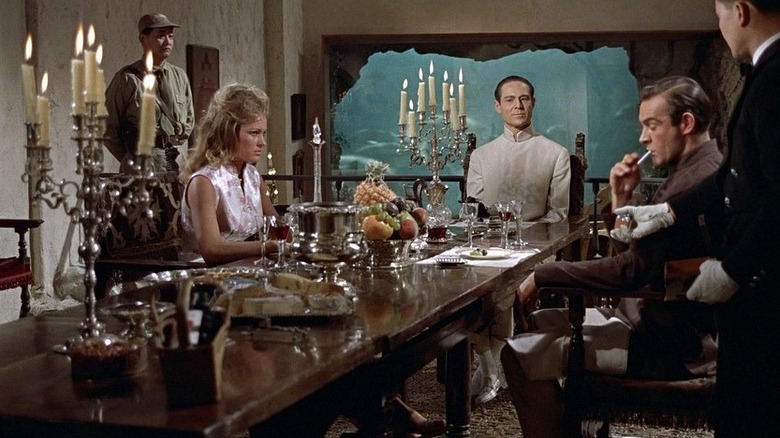The James Bond Movie Dr No Turned A Real Art Heist Into A Brilliant Easter Egg
Terence Young's 1962 actioner "Dr. No" — based on Ian Fleming's sixth James Bond novel — was not the first piece of filmed media to feature Fleming's notable Cold War spy James Bond, but it is still often considered the very first James Bond movie. It was certainly the first to feature Sean Connery as Bond, and it was the first overseen by Eon Productions, the longtime holders of the 007 film rights. It may be seen as the first in a long line of "canonical" Bond flicks, a line that lasts to this day. Amazon owns 007 now, so the future of the franchise remains to be discovered.
It's been fun to watch James Bond evolve over the years. In 1962, Bond was an oversexed, liquored-up charmer, the sexiest spy that MI6 had to offer. "Dr. No" featured plenty of sexism and racism that was de rigueur at the time, but James Bond fans prefer to remember it for its action, heroism, and sexual tension; this was the film that famously featured a scene wherein Ursula Andress wore a bikini. "Dr. No" is still fondly enjoyed, even if it is dated. Modern audiences, for instance, will have a hard time getting around the casting; the white, Jewish, Canadian-born, American-raised actor Joseph Wiseman was given special eye makeup to play the Chinese-German character of Dr. No. The character himself tapped into lingering World War II "yellow peril" fears, making him a little dated even in 1962.
Another slightly out-of-date gag that moderns audiences may not recognize is the inclusion of Francisco Goya's painting "Portrait of the Duke of Wellington." James Bond glances intently at the painting while strolling through Dr. No's secret villain lair partway through the movie. To modern audiences, it looks like just another painting, another great work of art that Dr. No had purchased or pilfered.
In 1962, however, the painting was famously missing, having been stolen from the London's National Gallery the previous August. The makers of "Dr. No" implied that the title villain was the culprit.
Dr. No featured a missing Goya painting
"Portrait of the Duke of Wellington" was begun by Goya from 1812 and completed in 1814, after the subject won the Battle of Salamanca. The Duke is wearing his military dress uniform, encrusted with many medals and honors that he won for his military prowess. The painting was passed down through the Duke's descendants for many years, eventually coming into the possession of one John Osborne, the 11th Duke of Leeds, in 1961. Osborne sold the painting at auction, where a charity called the Wolfson Foundation purchased it for the London National Gallery. It cost £140,000. The Gallery then put it on display on August 2.
"Duke" was stolen off the wall of the Gallery on August 21. A bus driver named Kempton Bunton waltzed out with the painting, taking it home and sitting on it for four years. According to an article in Forbes, Bunton had had conversations with security guards and learned that the painting's elaborate infrared security sensors were shut off for a spell early in the morning to allow for cleaning. Bunton waited until the sensors were off, snuck in through a bathroom window (which he had left cracked the night before) and snuck out with the good Duke. After keeping the painting for four years, Bunton returned it, dropping it off at a train station lost-and-found. He was apprehended by the police and put on trial, but the jury only sentenced him to three months in prison for stealing the frame. The painting was back and unharmed, so no harm, no foul, right?
At the time "Dr. No" was filming, though, none of these details were yet known. "Duke" was still missing, and no one knew who took it. British audiences would have known about the missing painting, of course, and snickered when they saw it in Dr. No's lair. Dr. No is a bad guy, so of course he was the one who stole "Duke."
The art theft reference is obscure today, but now you can impress people at parties with the above trivia.

